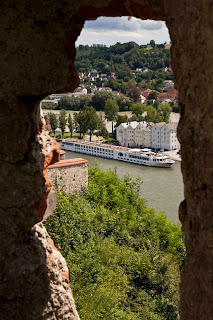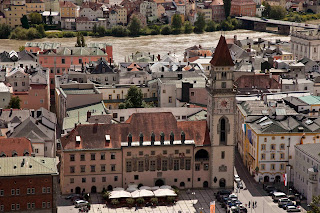
Late last evening we arrived at our dock in Passau. We later learned that this was not an altogether easy feat. We were the last boat to clear the bridge across the Danube. Because of the unprecedented rains in the area, the Danube’s water level is at flood stage and many of the cruise boats could not pass the bridges without taking off the bridge. In fact, a few weeks ago a French captain ignored the harbormaster’s high water warning and decapitated his boat. You gotta love the French! He is now trying to get a job driving a garbage scow without much success. The high water prevented Jeri and me from cycling along the Inn River because parts of the path were under water.
Passau is located near the Austrian and Czech borders at the confluence of three rivers, the Danube, the Ilz, and the Inn rivers. Its skyline is dominated by the clock tower of the rathaus (city hall) and the spires of Dom St. Stephan (St. Stephan’s Cathedral). Towering above the city is the fortress “Veste Oberhaus”.
We met our local guide, Daniel, at the wharf. He was by far the best guide we’ve had. It helped that he was a PhD candidate in German Literature at Passau University. He was a wealth of information on all that was German, history, music, literature, politics, etc. We walked around the cobblestoned streets of Passau, getting a chance to see the Baroque style of architecture. Passau is extremely old, but burned to the ground in the 1600’s and was completely rebuilt in the Baroque style. Our final stop of the morning was St. Stephan’s Cathedral, one of the finest examples of Baroque cathedrals in the world. The cathedral also boasts the largest cathedral organ in the world with 17,974 organ pipes, 233 stops, and 4 carillons. Each day at noon, a concert is given for the public which we were fortunate to be able to attend. The program was extremely varied including works of Bach and others from the late 17th and 18th centuries through 20th century artists. Though not a big fan of organ music, the sound of this enormous instrument in the cathedral was impressive.
After working up an appetite listening to the organ music, we decided to continue our quest for a pretzel. We had passed several bakeries on our walk and were certain a pretzel was in our future. We immediately found a bakery outside of the cathedral, and there they were. We ordered 2 pretzels (Betty, you would be very proud of me-“Zwei pretzel, bitte”) for ½ Euro each. I was astounded. You could buy 6 or more Bavarian pretzels for the cost of one NYC pretzel! Alas, the pretzel we had searched for did not live up to expectations. It was rather tasteless compared to NY pretzels. We decide that this had to be an anomaly, and we would try another bakery. This time we purchased only one, but a real good looking apple strudel was calling to me, so fro 3 euros, we got a pretzel and about a ½ lb of strudel. The pretzel was no better and we decided to wait for additional pretzels until our next trip to Manhattan. But, the strudel was amazing! We shared it with some shipboard friends since we couldn’t possibly finish it all. Ironically, that day on board ship we had both pretzels and strudel for lunch and dinner.
Since we had eaten all those carbs, we decided to hike to the Veste Oberhaus. The fortress was built in 1219 by Passau’s Prince-Bishops to control commerce across the rivers. In the early 19th century during the Napoleonic Wars, it became one of the strongholds against the Austrians. Over the years it was expanded several times and today consists of gothic, renaissance, and baroque styles. Commanding a killer view of the Danube, Ilz, and Inn Rivers as well as the town of Passau, it is now a museum and lookout great for taking photos of the beautiful architecture of Passau.
Before we left Passau, Jeri wanted to walk to the point of land where the 3 rivers came together. There was a small park with a small zip line that she couldn’t resist. We were then off in the late afternoon for our next destination, Melk, Austria.












No comments:
Post a Comment